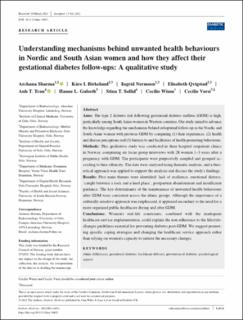Understanding mechanisms behind unwanted health behaviours in Nordic and South Asian women and how they affect their gestational diabetes follow-ups: A qualitative study
Sharma, Archana; Birkeland, Kåre I.; Nermoen, Ingrid; Qvigstad, Elisabeth; Tran, Anh T.; Gulseth, Hanne L.; Sollid, Stina T.; Wium, Cecilie; Varsi, Cecilie
Peer reviewed, Journal article
Published version
Permanent lenke
https://hdl.handle.net/11250/2772599Utgivelsesdato
2021Metadata
Vis full innførselSamlinger
Originalversjon
Sharma, A., Birkeland, K. I., Nermoen, I., Qvigstad, E., Tran, A. T., Gulseth, H. L., Sollid, S. T., Wium, C., & Varsi, C. Understanding mechanisms behind unwanted health behaviours in Nordic and South Asian women and how they affect their gestational diabetes follow-ups: A qualitative study. Diabetic Medicine, Artikkel e14651. https://doi.org/10.1111/dme.14651Sammendrag
Aims: The type 2 diabetes risk following gestational diabetes mellitus (GDM) is high, particularly among South Asian women in Western countries. Our study aimed to advance the knowledge regarding the mechanisms behind suboptimal follow-up in the Nordic and South Asian women with previous GDM by comparing (1) their experiences, (2) health and disease perceptions and (3) barriers to and facilitators of health-promoting behaviours.
Methods: This qualitative study was conducted in three hospital outpatient clinics in Norway, comprising six focus group interviews with 28 women 1–3 years after a pregnancy with GDM. The participants were purposively sampled and grouped according to their ethnicity. The data were analysed using thematic analysis, and a theoretical approach was applied to support the analysis and discuss the study's findings.
Results: Five main themes were identified: lack of resilience, emotional distress, ‘caught between a rock and a hard place’, postpartum abandonment and insufficient guidance. The key determinants of the maintenance of unwanted health behaviours after GDM were consistent across the ethnic groups. Although the importance of a culturally sensitive approach was emphasised, it appeared secondary to the need for a more organised public healthcare during and after GDM.
Conclusions: Women's real-life constraints, combined with the inadequate healthcare-service implementation, could explain the non-adherence to the lifestyle-changes guidelines essential for preventing diabetes post-GDM. We suggest promoting specific coping strategies and changing the healthcare service approach rather than relying on women's capacity to initiate the necessary changes.
